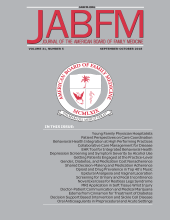Article Figures & Data
Tables
Codes in Each Cluster Abbreviated Definitions of Codes Technical cluster Structuring interaction Discussing what is to be accomplished in current interactions History taking Physician inquiring about or patient describing details related to the current complaint or to prior illnesses Family information Discussing family, medical, or social history and/or current family functioning Physical examination Any aspect of physical examination of patient Evaluation feedback Physician telling patient about results of history, physical, laboratory work, etc. Planning treatment Physician prescribing a medication, diagnostic, or treatment plan Treatment effects Physician inquiring about or patient describing result of ongoing therapeutic intervention Procedure Any treatment or diagnostic procedure done in office Health behavior cluster Compliance Discussing previously requested behavior Health education Physician presenting information to patient regarding health Health promotion Physician asking for change in patient’s behavior to increase or promote health Nutrition Any question about or discussion about nutrition Exercise Any question about or discussion about exercise Addiction cluster Substance use Any question about or discussion of drinking alcohol or use of other substances Smoking behavior Any question about or discussion of smoking or use of tobacco Patient activation cluster Health knowledge Physician asking or patient spontaneously offering what patient knows or believes about health and disease Patient question Patient asking question Chatting Discussing topics not related to current visit Preventive service cluster Preventive service Physician discussing, planning, or performing any screening task for disease prevention Counseling Cluster Counseling Physician discussing interpersonal relations or current emotional state of patient or patient’s family Those Davis Observation Codes in bold print are included in the modified version of DOC, which measures Patient-Centered Care.
- Table 2.
Sociodemographic and Health Data for All Study Patients (n = 509) and Patients with Yearling Patient-Centered Care Below (n = 254) and Greater than or Equal to (n = 255) the Median
All Patients (n = 509) <Median (n = 254) ≥Median (n = 255) Sex (%) Male 38.11 39.37 36.86 Female 61.89 60.63 61.14 Age (mean years [SD]) 41.74 (14.73) 42.24 (14.30) 41.24 (15.15) Education (mean years [SD]) 12.61 (2.73) 12.32 (2.59) 12.89 (2.85) Income* (%) <$10,000 49.11 55.56 42.69 $10,000–$19,999 24.75 24.60 24.90 $20,000–$29,999 10.50 10.32 10.67 $30,000–$39,999 6.14 2.38 9.88 $40,000–$49,999 4.16 3.97 4.35 ≥$50,000 5.35 3.17 7.51 Physical health status† (n [mean]) 40.44 (11.88) 39.01 (12.07) 41.87 (11.53) Mental health status† (n [mean]) 43.99 (12.55) 43.92 (12.36) 44.05 (12.76) BMI (mean) 29.76 (8.39) 29.19 (7.85) 30.33 (8.87) Alcohol abuse (%) 7.69 9.84 5.53 Smoker (%) 67.85 74.41 61.26 Below Median Patient-Centered Care (n = 254) Equal or Above Median Patient-Centered Care (n = 255) Mean (SD) Median (Range) Mean (SD) Median (Range) Type of visits Primary care 3.64 (2.94) 3.00 (1–24.00) 3.66 (3.38) 3.00 (1–24.00) Specialty care 2.94 (4.50) 1.00 (0–26.00) 2.22 (4.06) 0.00 (0–21.00) Emergency department 0.35 (0.98) 0.00 (0–8.00) 0.22 (0.65) 0.00 (0–4.00) Hospitalizations 0.25 (0.75) 0.00 (0–6.00) 0.11 (0.42) 0.00 (0–3.00) Diagnostic services 10.42 (11.86) 7.00 (0–90.00) 7.42 (9.63) 5.00 (0–89.00) Type of charges ($) Primary care 338.18 (267.00) 274.00 (0–1,893.10) 322.34 (312.37) 222.50 (0–2,017.00) Specialty care 646.37 (1,758.88) 128.00 (0–16,528.10) 329.41 (746.67) 0.00 (0–6,168.00) Emergency department 550.93 (1,913.96) 0.00 (0–18,782.50) 256.35 (846.09) 0.00 (0–6,596.50) Hospitalizations 5,360.35 (22,566.23) 0.00 (0–194,958.50) 2,547.00 (11,266.65) 0.00 (0–123,446.00) Diagnostic services 1,413.30 (2,311.54) 532.00 (0–23,190.50) 886.30 (1,368.26) 390.50 (0–10,645.50) Total charges 8,308.32 (24,811.19) 1,435.00 (49.5–203,234.50) 4,341.40 (12,575.57) 948.00 (0–134,788.50) - Table 4.
Two-Part Regression Models for Utilization of Specialty Care Clinic and Charges Using Patient-Centeredness, Sex, Age, Education, Income, Obesity, Smoking, Alcohol Abuse, Mental and Physical Health Status as Explanatory Variables
Dependent Variable Independent Variable* Utilization† Charges‡ Odds Ratio (95% CI) P SE P R2 Specialty Care Clinic (n = 260) Female sex 1.636 (1.083–2.471) .0192 −0.0127 .8427 0.1086 Age 1.026 (1.012–1.040) .0003 0.1168 .0653 Education 1.005 (0.933–1.082) .8972 −0.0052 .9348 Income 1.020 (0.947–1.099) .5944 0.0223 .7376 Obesity 1.705 (1.157–2.514) .0070 −0.0360 .5592 Smoking 1.153 (0.756–1.757) .5088 0.0187 .7684 Alcohol abuse 2.210 (1.041–4.692) .0391 −0.0533 .3932 Mental health status 1.010 (0.994–1.026) .2285 0.0810 .1962 Physical health status 0.979 (0.963–0.996) .0154 −0.1423 .0266 Patient-centered care 0.966 (0.934–0.999) .0417 −0.2239 .0005 ↵* All independent variables are baseline measurements except for the patient centered care, which is averaged over 1 year of care.
↵† Utilization results were obtained by logistic regression models.
↵‡ Medical charges for specialty care are in log-transformed dollars, with mean 6.04 (SD, 1.24).
SE, standardized error.
- Table 5.
Standardized Estimates from Regression Equations in Which Total Medical Charges* are Explained by the Average Percentage of Patient-Centered Care Over the 1-Year Study Period, Controlling for Baseline Patient Sex, Age, Education, Income, Physical Health Status, Mental Health Status, Obesity, Alcohol Abuse, and Smoking (n = 494)
Dependent Variable Independent Variables† SE P R2 Total charges (primary, specialty, and emergency care, hospitalizations and diagnostic services) Female sex 0.1098 .0115 0.2142 Age 0.2332 <.0001 Education −0.0121 .7803 Income −0.0119 .7878 Physical health status −0.2327 <.0001 Mental health status 0.0023 .9564 Obesity 0.0806 .0511 Alcohol abuse 0.0405 .3317 Smoking 0.0773 .0701 Patient-centered care −0.1575 .0002 - Table 6.
Standardized Estimates from Regression Equations in which Total Medical Charges* are Explained by the Average Percentage of Patient-Centered Care Over the 1-Year Study Period, for Female Compared to Male Patients Controlling for Baseline Patient Age, Education, Income, Physical Health Status, Mental Health Status, Obesity, Alcohol Abuse, and Smoking
Independent Variable† Women (n = 306) Men (n = 188) SE P R2 SE P R2 Age 0.2339 <.0001 0.1547 0.2530 .0002 0.3118 Education 0.0351 .5370 −0.0672 .3248 Income −0.0684 .2412 0.0781 .2535 Physical health status −0.1647 .0043 −0.3460 <.0001 Mental health status 0.0178 .7480 −0.0263 .6822 Obesity 0.0764 .1622 0.0791 .2223 Alcohol abuse 0.0029 .9583 0.0621 .3356 Smoking 0.0838 .1453 0.0896 .1707 Patient-centered care −0.1292 .0255 −0.1889 .0045






